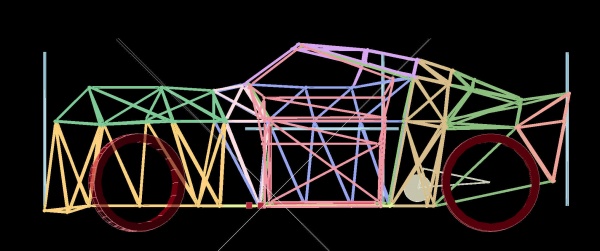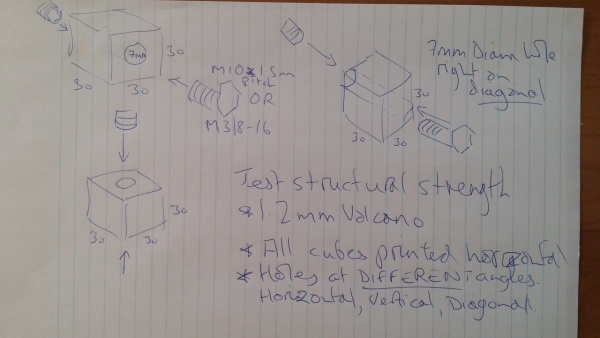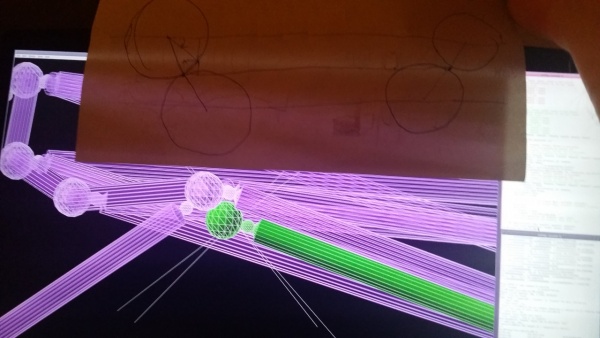UELVE MBC/v0.0
Contents
Frame Concept v0.0
Blue pipes are 1m measure sticks. Note that the body takes whatever form we would like.
Minumum Viable Product
- 4 wheels using mountain bike 19in rims and 2.75/19 motorcycle tires (26in outer diameter)
- 100kg weight (full, complete vehicle)
- 2 occupants
- Twin 3-5kW Axial Flux BLDC chain-driven motors (no gearbox needed)
- 1.1 x 1.5 x 3.4 metre dimensions with an "airbox" down the centre
- Only a 1.1 m^2 front surface area (due to the "air tunnel")
- 0-60mph in under four seconds (Sur-Ron "3" kW Motors can be pushed to 13kW for short durations, and there's two of them)
- over 200mpg at 55mph due to low weight, low rolling resistance, reduced surface area and low drag coefficient.
- capable of driving up a 50% gradient at around 25mph with 2 occupants.
Final Build Specifications (Post Build Tests)
Notes
- While world records are held for under 3 seconds, under 4 seconds is close to world records. [1]. We can emphasize here that for "acceleration per horsepower", ours here is probably a world record. Luke - have you done the numbers on this one?
- with the simulator i wrote a few years ago, yes. link at bottom of page. it's the reduced weight, reduced drag coefficient and the SurRon axial flux motors which can do 13KW for short bursts that do it. the world record is an MIT team EV with 4 hub motors. 0 to 60 in 1.9 seconds. in the slo mo the walls of the tires actually buckle under the acceleration.
Correction: that MIT team has been beaten by AMZ, who officially managed 0 to 60 (100km/h) in 1.513 seconds
Basic Design Concept
- Use high-end downhill mountain-bike parts that have been proven to be light, strong and effective up to a 50kg weight with an 80kg load, thanks to the Sur-Ron Electric Bike.
- Use twin Sur-Ron direct-drive 3-5kW Axial Flux electric motors
- Use twin ASI BAC4000 BLDC Controllers (or VESC Vedder BLDC Controllers http://vedder.se/2015/01/vesc-open-source-esc/)
- Outer skin using the GABoats technique (Geodesic Aerolite Boats) - http://gaboats.com
- Inner frame using 3D-printed fibre-reinforced "nodes" connecting continuous-fibre-reinforced pipes on a Fibre_Reinforced_Pipe_3D_Printer or getting carbon-fibre, hemp-reinforced tubes (or even Bamboo), based on the Divergent 3D "Blade" car manufacturing concept https://www.youtube.com/watch?v=vPv7PwS50OE
- Epoxy-soaked cloth "wrapping" carried out on joints, if necessary, using the Calfee Design Bamboo bike technique. https://calfeedesign.com/what-is-in-calfee-diy-kits/
- Swappable Modular batteries using the Open_Source_Battery_Pack
CAD Source Code
- git clone http://lkcl.net/vehicle_3d/.git
BOM
estimated, todo steering and suspension, estimated total under USD 4000 excluding tools and batteries.
- 3D printed 15mm x 2mm kevlar/hemp continuous reinforced pipes (250 metres)
- 3D printed "nodes" (120)
- Kevlar twine (see gaboats)
- Dacron (see gaboats)
- QTY 2 Shimano Saint M820 mountain bike hydraulic brake sets (2 front, 2 rear)
- QTY 4 19in diameter downhill mountain bike wheels
- QTY 4 2.75/19in Shinko "Goldenboy" tires
- QTY 4 Fox DHX2 rear suspension sets with orange spring
- QTY 2 Sur-Ron 3kW BLDC Axial Flux Motors
- QTY 2 Sur-Ron rear swingarm (or structurally strong 3D printed equivalent, TBD)
- QTY 2 20kW 3 phase BLDC Motor Controllers (Vedder VESC)
- 6 guage wire (appx 5 metres)
- QTY 15 (appx) Open Source Battery Packs per kWh
- Bus Bars connecting packs together
- Bearings (lots)
Materials
Nozzle Choice for Printing With Abrasive Composites
- Contacted Olsson Ruby because ordinary nozzles are not going to cut it.
- Tungsten Carbide Nozzles are also an option DyzeDesign's Site Sells Them ~50 USD
Pipe Materials
Filament
Natural
Synthetic
- kevlar: http://gaboats.com/products/
Core Plastic Options
Kevlar Reinforced CFF
- CFF kevlar plastic https://markforged.com/product/kevlar-cff-spools/
NylonX + Nylon K
- NylonX https://www.matterhackers.com/articles/create-custom-end-use-3d-printed-bike-parts-with-nylonx
found something that i think may work (worth investigating). NylonX and its newer cousin, NylonK.
https://www.matterhackers.com/store/c/NylonX
the case studies are awesome. a skateboard bushing, and a mountain bike pedal.
these look like they have the strength to make both the ends of the pipes *and* the nodes *and* are worth exploring to make gears and full rack and pinion steering, and even the suspension arms.
now the only way i would be happy to make rack and pinion steering 3D printed is if they were massively oversized. the pinion gear a whopping 3in in diameter or 2in diameter but also a massive 1.5in depth, making the rack 1.5 to 2in deep as well.
the force of an emergency turn, or at speed trying to hold the steering wheel against friction, this is not something you mess with.
so we see how that goes?
but, i really like the idea of fibre reinforced *nylon* (not PLA) because it is already strong, and higher temperature.
Material Strength Test
the logical reasoning behind this test is to find out if, with fibre-reinforced plastic, the layer adhesion affects strength of the part under load when bolts are screwed directly into it.
- two M10 1.5mm pitch bolts (or close: 3/8 with 1/16in pitch)
- a 30 x 30 x 30mm cube made of fibre reinforced plastic with a smooth cylinder hole down the middle about 7 or 7.5mm diameter
- print that using 100% infill, fibre reinforced plastic, with a minimum 0.8mm nozzle, preferably 1.2mm, with the hole pointing UPRIGHT.
- screw the two M10 bolts in, using the thread to "tap" the holes, making them meet in the middle
- hang it from a bench by 1 bolt and keep putting weights on it until it breaks.
i need to know, how much weight it took. it might be a lot, before the cube breaks or the threads strip.
the next test is printing it where the hole is horizontal.
the "more advanced" version of that is for the hole to be at 45 degrees through the cube, i.e to test the effect of diagonal layers.
Testing Machine
- User:Eric here again, it is a luxury, and not too necessary, but would lead to high quality measurements for things like advertising, and reputability
- I have been conjuring up a Open Source Universal Material Science Destructive Testing Machine
- it can basically measure all the various stresses. Compressive Strength and Tensile Strength are the main ones, but Shear Strength and Torsional Strength may be of use as well
- It basically just a semi-fleshed out idea at this point but perhaps this could lead to it being developed a bit
- Load cells could be used for high end, but a semi accurate hook scale (like a luggage scale) may work just as well
- Then perhaps geared down servos?
- Some Lab Grade Ones That I have seen use a pendulum that is lifted and dropped, this may be something to consider
- Also some youtube channels (3D Printing ones mainly) do some of these tests every now and then so check those out if you haven't already
- Also there are various Standardized Material Science Testing Forms of 3d prints and other objects (An S hook, a solid bar, your pipe, etc) so this could use those at least
Expected Issues
One key issue to watch out for is the block cracking as the M10 bolt is screwed in. Normally, a tap/die would be considered, here.
The problem is that when using 1.2mm nozzles, it is extremely unlikely to be able to 3D print a matching 1.5mm thread for the bolt to fit in, therefore tapping the hole is the next option, and seeing if the bolt itself will achieve that is logical to attempt.
One alternative ie to look for very coarse threaded M10 bolts, or even trapeoizoidal bar, or, if this really doesn't work, some alternative lock mechanism, or a much larger diameter hole and use epoxy glue. of course, epoxy glue you are never going to be able to remove the bolt.
TODO
- Simulation (playable game) using ODE (Open Dynamic Engine) which will be cool and also test real-world joint strength and drivability. See Hackrod. https://youtu.be/v__qoJsAs48 (note about Hackrod: everything about it is entirely proprietary software, based on cloud services. no source code is made available).
Notes from Julia log
https://wiki.opensourceecology.org/wiki/ImplicitCAD#Julia
- When recycling fibre reinforced plastic, the fibres get shorter and shorter. (possible solution: add more back in?)
- Carbon fibre is energy intensive to produce, is often produced using non renewable energy, and is sometimes processed, or coated with harmful substances. It is also rather hard to recycle ( see Enviromental Impact of Carbon Fiber (not going to use carbon fibre, use hemp fibre or wood fibre, see Da Ai Technology in taiwan) ( User:Eric here, have you considered semi-synthetics? You basically dissolve cellulose, undissolve it through a nozzle, and in turn get a natural fiber that has been processed for better properties (mainly consistency, i'm still trying to get hard facts on this (tensile strength etc) either way this project is going to be great so no pressure)
- use detroit technique: 3 pieces, front middle and back. matches with what i suggested, given that big printer is aiming for 4x4x8 ft. roof and floor will probably need to be separate in this design (so, 4 pieces)
Questions and Comments
- what kind of fibre plastic? answer: don't know enough to say. ideally several materials should be tested and the results fully documented.
- what diameter hole? assuming using the bolt as self-tapping, an M10 bolt with 1.5mm pitch has around a 1.5 mm inset, therefore 10mmm minus 1.5x2 equals 7mm, so between 7 and 7.5mm seems sensible to try. bottom line: if it cracks on insertion, the hole was too small!
- how should the weights be hung? doesn't matter as long as side-twisting is avoided (we are not testing shearing or twisting, here, yet, just pulling). strong rope tied or clamped to both bolts, one end fixed to a table, the other has weights attached, it doesn't matter. doesn't have to be sophisticated, here.
Videos
Screenshots / Images
See Also
- Two Wheeled Velomobile
- Velomobile
- Summer_of_Extreme_Design-Build_and_Startup_Camp_Overview_of_Learning_Program






